MSI RTX 4070 Gaming X Trio
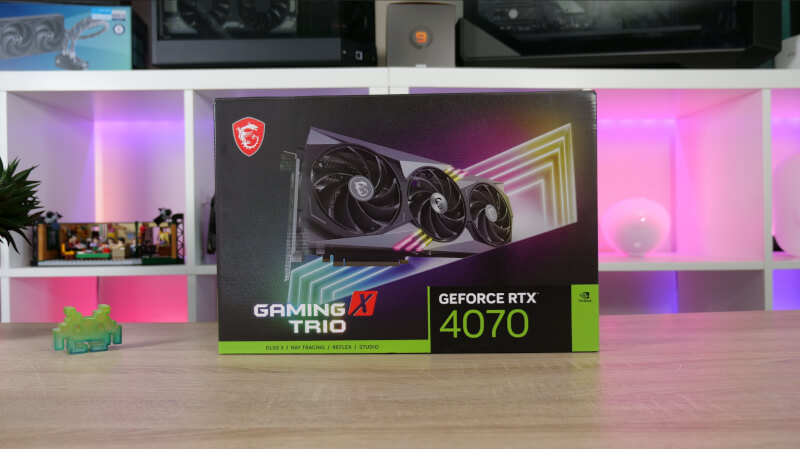
Specifications
- MODEL NAME: GeForce RTX™ 4070 GAMING X TRIO 12G
- GRAPHICS PROCESSING UNIT: NVIDIA® GeForce RTX™ 4070
- INTERFACE: PCI Express® Gen 4
- CORE CLOCKS: Extreme Performance: 2625 MHz (MSI Center) - Boost: 2610 MHz
- CUDA® CORES: 5888 Units
- MEMORY SPEED: 21 Gbps
- MEMORY: 12GB GDDR6X
- MEMORY BUS: 192-bit
- OUTPUT: DisplayPort x 3(v1.4a)
- HDMI™ x 1 (Supports 4K@120Hz HDR, 8K@60Hz HDR, and Variable Refresh Rate as specified in HDMI™ 2.1a)
- HDCP SUPPORT: Yes
- POWER CONSUMPTION: 215 W
- POWER CONNECTORS: 16-pin x 1
- RECOMMENDED PSU: 650 W
- CARD DIMENSION (MM): 338 x 141 x 52 mm
The most direct comparison that we can draw here is of course the RTX 4070Ti card that we have looked at previously. We can see that we go from 7680 CUDA Cores down to 5888. It's a bit disappointing to see that we don't get more CUDA cores than we saw on the RTX 3070 card. So no improvement since the last generation.
At the same time, the announced Boost Clock also falls just over 100 MHz compared to the RTX 4070Ti card.
However, the RAM configuration is the same.
A tour around the MSI RTX 4070 Gaming X Trio
The Gaming X series from MSI is by now a well-established series, and the design is clearly recognizable here if you have seen a card in the series before.
Over time, the design has become slightly sharper at the edges, but it is the same relatively muted gunmetal gray and black design that we know from the series.
As the name suggests, there are three of MSI's Torx 5.0 fans set up in MSI's Tri Frozr cooling setup.
The fans sit above the large aluminum cooler underneath, which is supplemented by five heatpipes and a copper base plate to optimize cooling. The cooler extends considerably beyond the length of the graphics card itself.
It is very clear that three coolers have become part of the card, probably primarily to be able to include it in the Gaming X Trio series. In fact, only about 1½ coolers are actually placed above the circuit board on the graphics card. The rest extends further than the card and this means that the air can blow directly through the cooling fins.
The slightly special setup also results in a slightly different location of the power plug on the card. It is with the new 12VHPWR connector, which is located in the middle of the card by a cutout in the card's backplate. The cooling solution is also quite a bit wider than the card itself.
An adapter is included for the new 12VHPWR connector, if you do not have one of the new ATX 3.0 power supplies that come with the connector. However, the adapter here is slightly smaller than on the large cards in the 4000 series and only requires two PCIe connectors.
As I said, the card is also provided with a backplate that matches the style of the card. There is a large cutout on a large part of it that allows the air to pass directly through the cooling fins.
There are two RGB zones on the card which can be set via MSI's software. There is one around the center fan and then an MSI logo on the side of the card.
If we look at the connections, we get three DisplayPort 1.4a and a single HDMI 2.1a, which can draw up to 4K at 120 Hz.
The test
We skip straight to the test itself and see how the card performs in our selection of test games.
All tests have taken place on our AMD-based test bench with the following hardware:
- Motherboard: ASUS ROG Crosshair X670E Hero
- CPU: AMD Ryzen 9 7900
- RAM: 32 GB Kingston Fury DDR5 @6000 MHz
- PSU: Seasonic Vertex GX-1000
All cards included in the comparison have of course also been tested on the same setup.
The first step is to get an overview of the baseline results and I do that by letting the system run for 30 minutes with a Heaven stress test.
Here the card peaked with a clock speed of 28400 MHz, so a nice notch above the 2610 that MSI itself lists on their website for the card.
The temperature peaked at just 52 degrees, so the massive cooling solution pulls good results with you.
The card is not only solidly cooled, it also does the job virtually silently. I measured the card at only 37 dbA under full load, which is the MSI RTX 4070Ti Suprim card that I tested earlier this year. The two are the quietest cards I have tested to date.
Play test
We skip ahead to our playtest to see how the card performs. All tests here are conducted without the use of DLSS, render scaling or other similar technologies, so this is a test of pure raw performance.
Cyberpunk 2077
- High Preset - NO DLSS - NO AMD Fidelity FX - Dynamic Resolution Scaling = OFF
Here we can see that the RTX 4070 Gaming X Trio unsurprisingly has difficulty participating in 4K. Here we are well below 60 FPS and for a game of this type it will be a challenge.
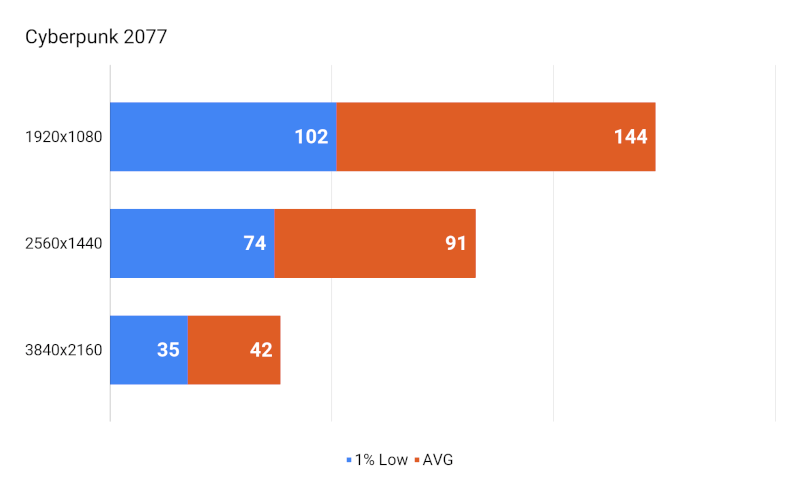
1440p and 1080p look significantly better and you will easily be able to participate here. There are also solid 1% results at both of these resolutions.
.png)
If we look at the comparison, we can see that there is of course some distance up to the RTX 4090 card. However, it is most pronounced in 4K and 1440p.
If we look at the other cards, the 4070Ti is the card over, while we can fortunately say that the last generation 3070Ti is beaten. Again, however, it is most pronounced at lower resolutions.
Assassin's Creed Valhalla
- High Preset - Resolution Scale: 100% - Adaptive Quality = OFF
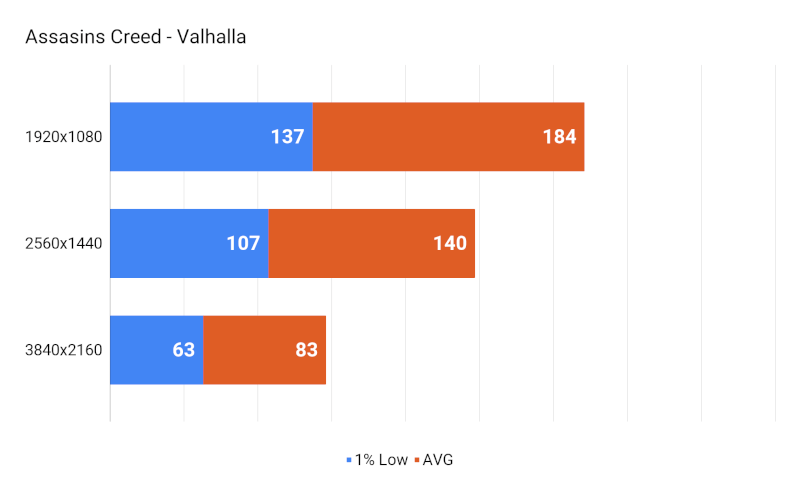
Assasins Creed Valhalla is a bit more forgiving of graphics cards, but can still be a demanding game. Here, however, the RTX 4070 Gaming X Trio can easily be included in all three tested resolutions. Even 4K lands with good playable FPS results of 80 on average and solid 1% results to back it up.
.png)
Looking at the comparison, the story is the same as Cyberpunk 2077.
Outriders
- Ultra Preset - DLSS: OFF - Resolution Scaling: 100%
Outriders is the next game on the list, and here the card is again pushed a bit at 4K. We're still above 60 FPS though, but it's right on the edge. Here, however, the 1% results pull that result down a bit.
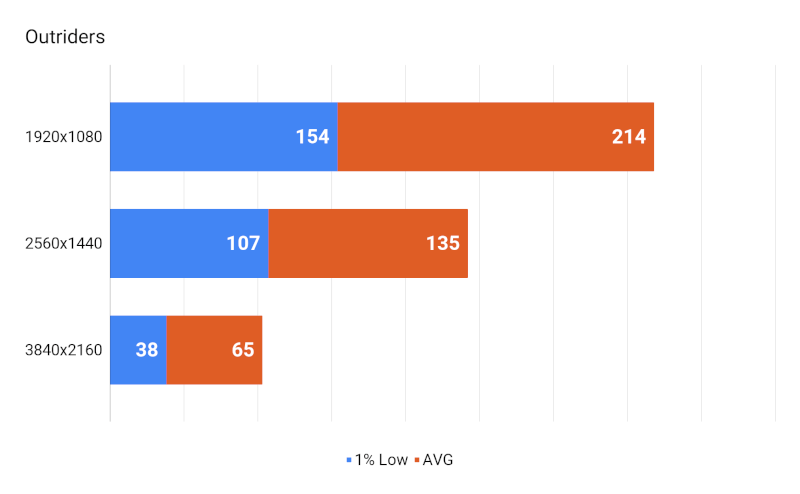
However, the lower resolutions are no problem with triple digit results on both average FPS and 1%.
.png)
In the comparison we see the same results as in the previous games.
Overwatch 2
- Ultra Preset - Ultra Preset - Render Scale: 100% - Dynamic Render Scale: OFF - High Quality Upsampling: OFF
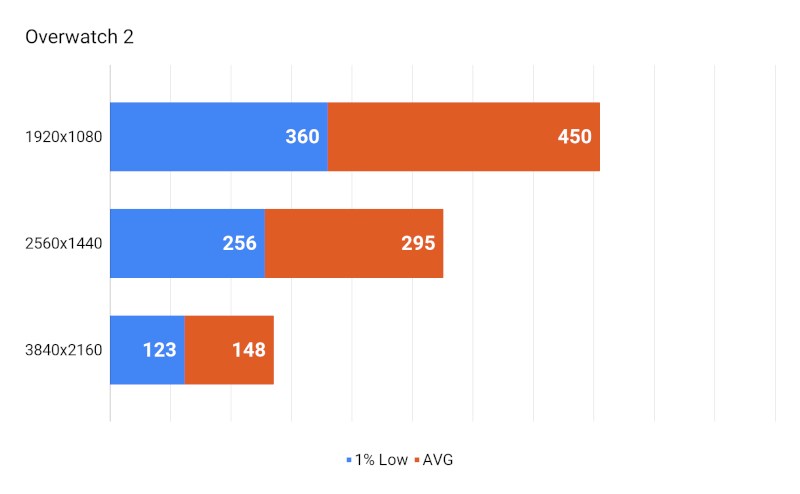
The last game in the series is the easiest, and of course this can also be seen in the results. Here are three-digit results on all three solutions tested.
.png)
Again, we see in the comparison the same trend as before. Here, however, the results are so high that it will really be difficult to notice a difference, even between the fastest and the slowest card.
Ray Tracing
Usually, until now, we have not tested Ray Tracing performance when we have tested graphics cards. It has been with the argument that it has been quite limited, how widespread it was and how many cards supported it, in a sensible way.
However, with the new 4000 series of cards from Nvidia, and the improvements that time has brought, we have decided to take it with us. That way you can hopefully get a bit of an idea of how the cards we test in the future compare to each other in terms of Ray Tracing performance.
However, Ray Tracing is quite difficult to test in a good way. The bottom line is that there are almost as many implementations of Ray Tracing as there are games that support it. It is not a complete package, and the game producers can choose to use very few, or all options available in Ray Tracing.

Therefore, the hardware requirements can vary greatly from game to game, even if you play with Ray Tracing enabled in all of them. For our tests of Ray Tracing, we have chosen to test with Cyberpunk 2077. We do this because it is one of the games on the market today that has the most extensive Ray Tracing support. This means that it is a game that can form the basis for deeper tests of Ray Tracing, if we have to do a more thorough test of it at a later stage.
However, it is also important to emphasize that the test here, like the other tests for that matter, is only a snapshot of the performance based on the exact game and the settings we have tested with. So it is not the definitive answer to how good a graphics card is for Ray Tracking. The test was made to give an idea of the relative strength of the tested cards in a number of selected games.
However, we hope that the test can be used as a basis for a comparison between the RT performance on different cards. All tests have also been completed without the use of DLSS, AMD Fidility FX or other similar technologies or render scaling.
So it is the pure raw Ray Tracing performance, without the help of any of the tools.
Cyberpunk 2077 - Ray Tracing
- Ray Tracing Medium Preset - NO DLS
Here we can see that the RTX 4070 card really cannot participate when it comes to Ray Tracing at anything other than 1920x1080, where we can squeeze above 60 FPS.
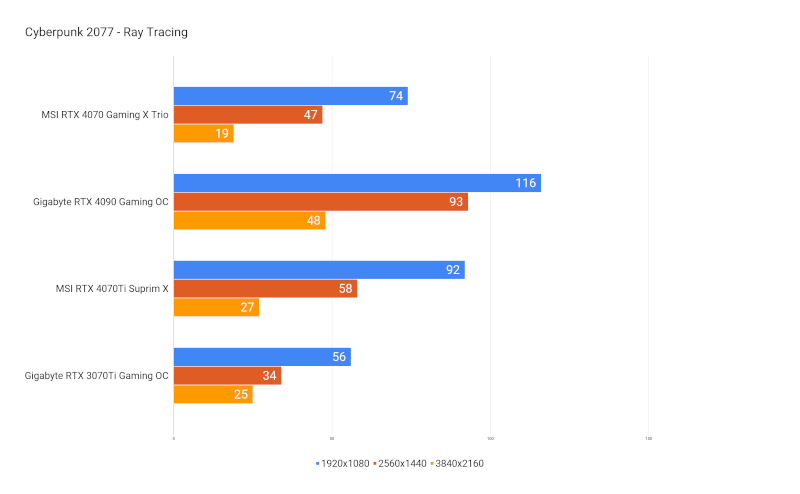
It will of course be able to improve with the use of DLSS or Fidility FX. It's also very nicely in line with the story Nvidia wants to tell. They are focusing more and more on their DLSS in the field management and not so much on the real performance on the cards.
DLSS is really nice and can give super good results. The challenge is just that there are still quite a few games that support DLSS. It should therefore not form the basis for which card you buy, unless you play a few very specific games where it is supported.
Price
I can currently find the MSI RTX 4070 Gaming X Trio with an online price of just under 950$. It is around 120$ more expensive than the cheapest RTX 4070 cards I can find. So here you definitely pay for MSI's large cooler and design.
In comparison, RTX 3080 cards are still sold at prices around 1000-1100$.
Conclusion
With their RTX 4070 Gaming X Trio, MSI has made a beautiful and super well cooled, and not least quiet, card. However, it comes with a price that is almost 750$ above other, not so overkill, cards in the RTX 4070 selection.
Whether you see it as a strength or a weakness, I will leave it up to you to judge for yourself. However, I wish MSI had made a Gaming X Duo version perhaps, as the card really doesn't need such a big cooler. A smaller card could, for example, have been in many of the new ITX cabinets.
In terms of performance, the card lands roughly where you would expect. It will be about what we see with the RTX 3070TI/RTX 3080 cards from the last generation, which should also be the cards they have to beat.
However, it is managed here significantly cooler and quieter than the cards from the previous generation.
It is a solid card for 1440 gaming and with good possibilities for 4K in certain titles. I am still slightly dissatisfied that Nvidia has chosen to move down to a 192 Bit Memorybus on a card in this segment and price.
The Gaming X Trio card is beautiful, but personally I would have preferred a smaller version and if I had to go out and buy one, I would probably save the almost 750$ and take one of the other alternatives on the market.
Nvidia hasn't exactly done their fans/customers any great favors with the new series. The performance to price ratio has become skewed compared to what we have seen in previous generations. However, that seems to be the new reality. We can complain and grumble, but all things considered, it doesn't seem to change much in a market that, for a multitude of reasons, has been very strange in recent years.
If you take into account that the card here performs roughly like an RTX 3080, which is still sold for 800-950$, then an RTX 4070 is not a bad deal in that comparison.
We end up with a final grade of 8 for a card that performs really well and does it virtually inaudibly. However, you are allowed to pay extra for the silence with a price that is above average for the RTX 4070 field.
Pros:
- Super cooling
- Virtually silent
Cons:
- More expensive than the average RTX 4070 card
Latest graphics card
-
20 Margraphics card
-
13 Jangraphics card
ASRock B580 Steel Legend
-
07 Jangraphics card
ASUS showcases new AMD RX 9700 graphics cards
-
07 Jangraphics card
ASUS ready with large selection of RTX 50 graphics
-
07 Jangraphics card
Nvidia Reflex 2 reduces gaming latency
-
07 Jangraphics card
Nvidia launches DLSS 4 with the new RTX 50 series
-
07 Jangraphics card
Nvidia RTX 50 series is ready
-
07 Jangraphics card
Nvidia launches RTX 5090 at CES
Most read graphics card
Latest graphics card
-
20 Margraphics card
ASRock RX 9070 Steel Legend
-
13 Jangraphics card
ASRock B580 Steel Legend
-
07 Jangraphics card
ASUS showcases new AMD RX 9700 graphics cards
-
07 Jangraphics card
ASUS ready with large selection of RTX 50 graphics
-
07 Jangraphics card
Nvidia Reflex 2 reduces gaming latency
-
07 Jangraphics card
Nvidia launches DLSS 4 with the new RTX 50 series
-
07 Jangraphics card
Nvidia RTX 50 series is ready
-
07 Jangraphics card
Nvidia launches RTX 5090 at CES






